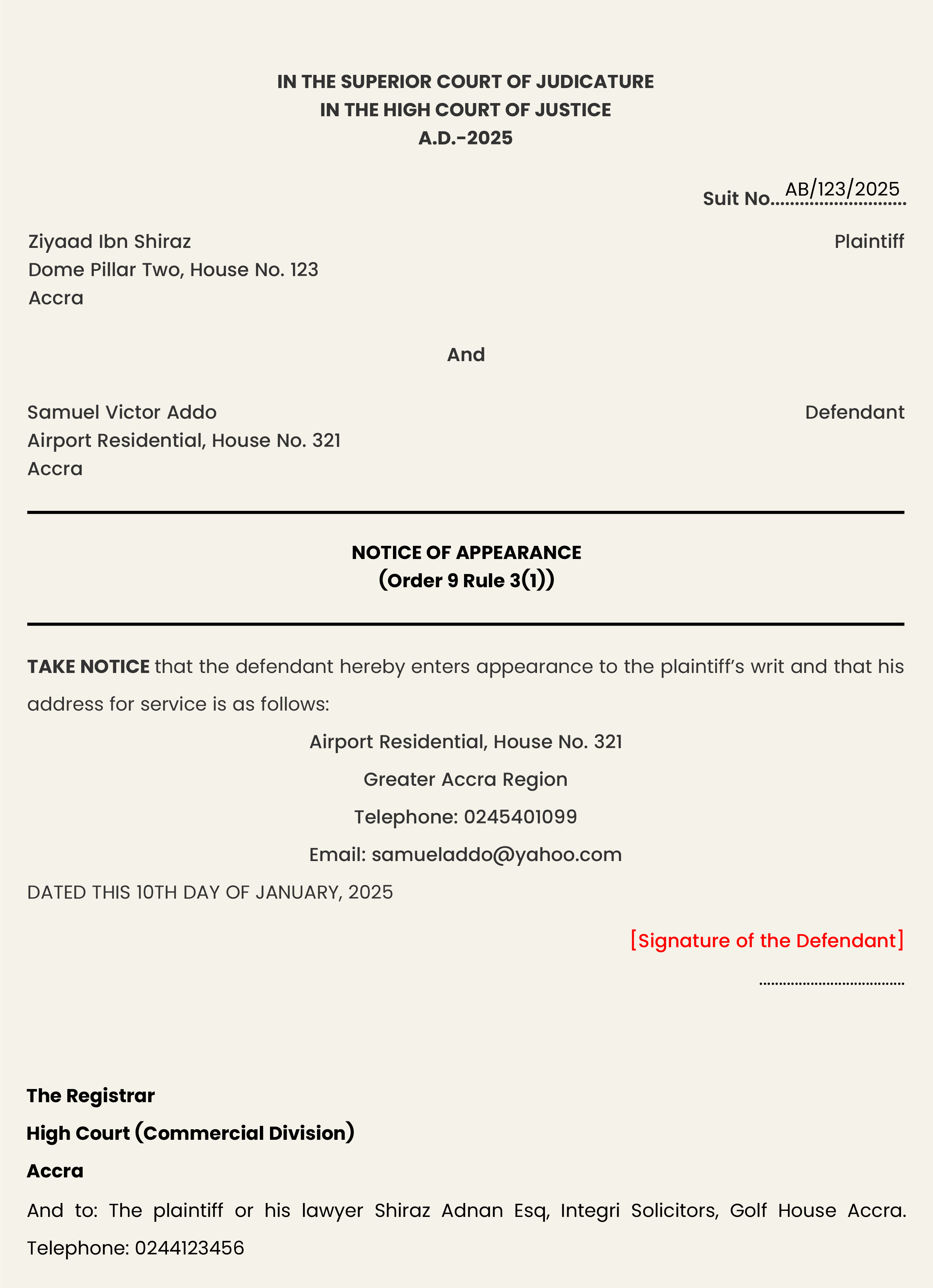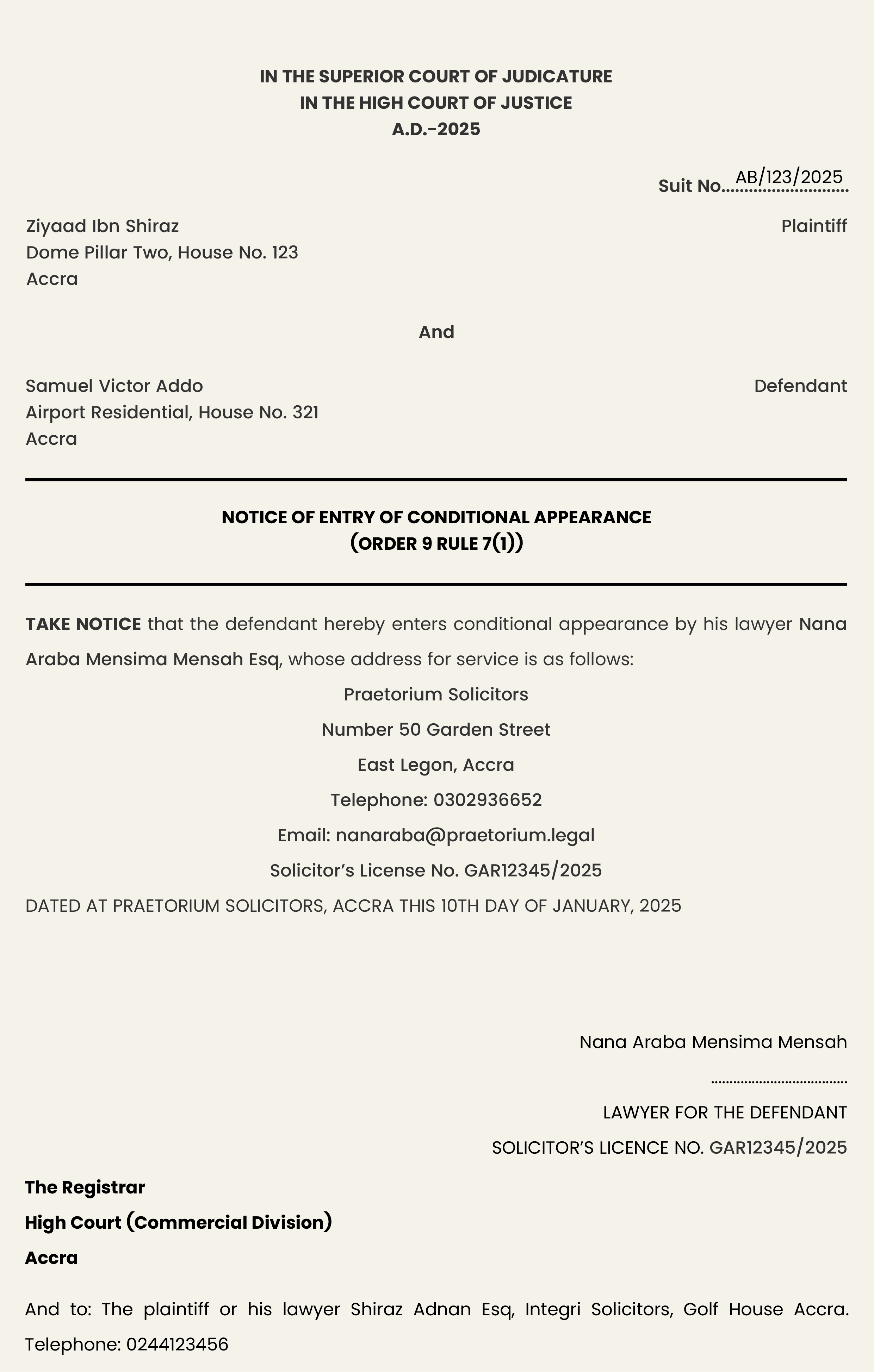Note on Appearance: An Introduction by Legum
Appearance: An Introduction
Introduction:
This note will discuss the rules governing the entry of appearance in Ghana upon service of a writ of summons. The note will briefly define appearance and proceed to discuss who enters appearance, how appearance is entered, the content of the notice of appearance, the types of appearance, and the time limit for appearance. The main order that will be used is Order 9 of the High Court (Civil Procedure) Rules, 2004 (C.I. 47).
Meaning of Appearance:
According to the Black’s Law Dictionary, appearance is:
A coming into court as a party or interested person, or as a lawyer on behalf of a party or interested person; esp., a defendant's act of taking part in a lawsuit, whether by formally participating in it or by an answer, demurrer, or motion, or by taking post judgment steps in the lawsuit in either the trial court or an appellate court
In Ghana, upon receiving a writ of summons, the defendant is expected to enter or file an appearance. This is simply the defendant’s way of acknowledging the receipt of the writ.
Who Can Enter or File Appearance:
Order 9 Rule 1 provides that:
Subject to Order 5 rule 1 of these Rules a defendant to an action may , whether or not the defendant is sued in a personal capacity or as a trustee or as a personal representative or in any other representative capacity, file appearance in the action and defend it in person or by a lawyer.
Thus, if the defendant is not a body corporate or disabled—that is, if the defendant is not below eighteen (18) years of age or incapable of managing his affairs due to a mental disorder or infirmity of mind—he may enter an appearance on his own or do so through his lawyer. If the defendant is a body corporate or is disabled, it must enter appearance through a lawyer.
How the Defendant Enters Appearance:
The defendant enters appearance by filing a notice of appearance at the registry. Per Order 9 Rule 3, the notice of appearance shall be as in Form 5. Below is an illustration of said Form 5:
1. Defendant Entering Appearance in Person:

2. Defendant Entering Appearance through his Lawyer:

Content of Notice of Appearance:
From the above samples, it is clear that the notice of appearance, in addition to including details such as the name of the court, the suit number, and the names of the parties, contains the following key elements:
1. Residential and Occupational Address of the Defendant: Per Order 9 Rule 1 (2), the defendant must state his residential and occupational address on the notice of appearance whether he defends in person or by lawyer and whether these addresses are stated on the writ or not. If the defendant fails to provide these addresses, Order 9 Rule 1(3)states that the plaintiff may apply to the court on notice to compel the defendant to do so and the cost involved shall be borne by the defendant and where the defendant fails to comply with the Court's order within the stipulated time, the defendant shall be considered to have not entered appearance. If the address is not genuine, Order 9 Rule 3(4) allows the plaintiff to apply to the court to set aside the appearance.
2. Address for Service: Per Order 9 Rule 3(1) , a notice of appearance shall specify an address for service. What constitutes the address for service depends on whether the defendant appears in person or through a lawyer:
a. If the defendant appears in person, the address for service shall be the defendant’s place of residence in Ghana; if the defendant has no place of residence in Ghana, the address of a place in this country where documents for the defendant may be delivered or sent.
b. If the defendant appears by a lawyer, the address for service shall be the business address of the lawyer in Ghana.
3. The Date of Handing or Sending it to Registry: Order 9 Rule 3(2), the notice of appearance is dated on the day on which it is handed in at, or sent by post to the registry.
4. Signature of the Defendant or his Lawyer: Order 9 Rule 3(2), if the defendant enters appearance in person, he shall sign the notice of appearance. However, if he enters appearance by a lawyer, the lawyer must sign the notice of appearance.
Types of Appearance:
In entering appearance, the defendant may enter:
- A conditional appearance.
- An unconditional appearance.
A conditional appearance is to enable the defendant who intends to object to the issue or service of the writ or notice of the writ on him, or to object to the jurisdiction of the court, to apply to the court to set aside the writ, or notice of the writ or the service thereof on him. This will be discussed extensively in subsequent notes.
An unconditional appearance, also known as a regular appearance, indicates that the defendant is ready to defend the case on its merits, submits to the jurisdiction of the court, and has no objection to the validity or service of the writ.
Time Limit for Entering Appearance:
A defendant must enter appearance within eight days upon service of the writ on him, including the date of service of the writ. This is provided in Order 9 Rule 5, which reads:
In these Rules references to the time limited for appearance are references
(a) in the case of a writ served in the country, to eight days after the service of the writ or where that time has been extended by the Court, within that time as extended; and;
(b) in the case of notice of a writ served outside the country, to the time limited by an order of the Court under Oder 7 rule 13(2) or Order 8 rule 4 or, where that time has been extended, to the extended time.
The effect of this provision is that the default time for entering an appearance is eight days, but this period may be extended by the court. In the case of service out of the jurisdiction, the time for appearance is the time specified by court.
Conclusion:
This note is merely introductory. In subsequent notes, we will discuss the conditional appearance and what happens if a party fails to enter appearance.
Speed
1x